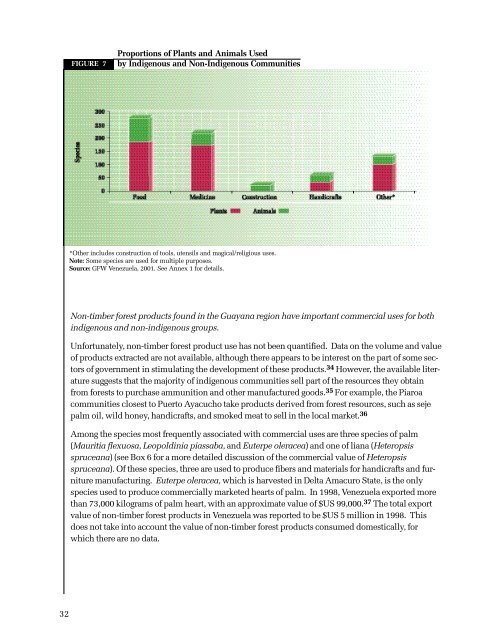Usar pâgs xvii-134 - ResearchGate
Usar pâgs xvii-134 - ResearchGate
Usar pâgs xvii-134 - ResearchGate
Create successful ePaper yourself
Turn your PDF publications into a flip-book with our unique Google optimized e-Paper software.
FIGURE 7Proportions of Plants and Animals Usedby Indigenous and Non-Indigenous Communities*Other includes construction of tools, utensils and magical/religious uses.Note: Some species are used for multiple purposes.Source: GFW Venezuela, 2001. See Annex 1 for details.Non-timber forest products found in the Guayana region have important commercial uses for bothindigenous and non-indigenous groups.Unfortunately, non-timber forest product use has not been quantified. Data on the volume and valueof products extracted are not available, although there appears to be interest on the part of some sectorsof government in stimulating the development of these products. 34 However, the available literaturesuggests that the majority of indigenous communities sell part of the resources they obtainfrom forests to purchase ammunition and other manufactured goods. 35 For example, the Piaroacommunities closest to Puerto Ayacucho take products derived from forest resources, such as sejepalm oil, wild honey, handicrafts, and smoked meat to sell in the local market. 36Among the species most frequently associated with commercial uses are three species of palm(Mauritia flexuosa, Leopoldinia piassaba, and Euterpe oleracea) and one of liana (Heteropsisspruceana) (see Box 6 for a more detailed discussion of the commercial value of Heteropsisspruceana). Of these species, three are used to produce fibers and materials for handicrafts and furnituremanufacturing. Euterpe oleracea, which is harvested in Delta Amacuro State, is the onlyspecies used to produce commercially marketed hearts of palm. In 1998, Venezuela exported morethan 73,000 kilograms of palm heart, with an approximate value of $US 99,000. 37 The total exportvalue of non-timber forest products in Venezuela was reported to be $US 5 million in 1998. Thisdoes not take into account the value of non-timber forest products consumed domestically, forwhich there are no data.32
















